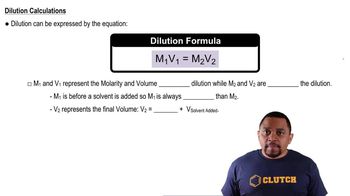Here are the essential concepts you must grasp in order to answer the question correctly.
Solubility Product Constant (Ksp)
The solubility product constant (Ksp) is a numerical value that represents the equilibrium between a solid and its ions in a saturated solution. For calcium carbonate (CaCO3), Ksp indicates the maximum concentration of Ca2+ and CO32- ions that can exist in solution before precipitation occurs. Understanding Ksp is essential for predicting whether a precipitate will form when the product of the ion concentrations exceeds this constant.
Recommended video:
Solubility Product Constant
Stoichiometry of Reactions
Stoichiometry involves the calculation of reactants and products in chemical reactions based on balanced equations. In this context, it is crucial to determine the moles of Na2CO3 added to the hard water and how it reacts with the available Ca2+ ions. This allows for the assessment of whether the concentration of carbonate ions will be sufficient to exceed the Ksp of CaCO3, leading to precipitation.
Recommended video:
Concentration and Dilution
Concentration refers to the amount of a substance in a given volume of solution, typically expressed in molarity (M). When mixing solutions, the final concentration of ions can change due to dilution or the addition of solutes. In this question, calculating the final concentration of carbonate ions after adding Na2CO3 is vital to determine if it will lead to the formation of CaCO3 precipitate.
Recommended video:
 Verified step by step guidance
Verified step by step guidance

